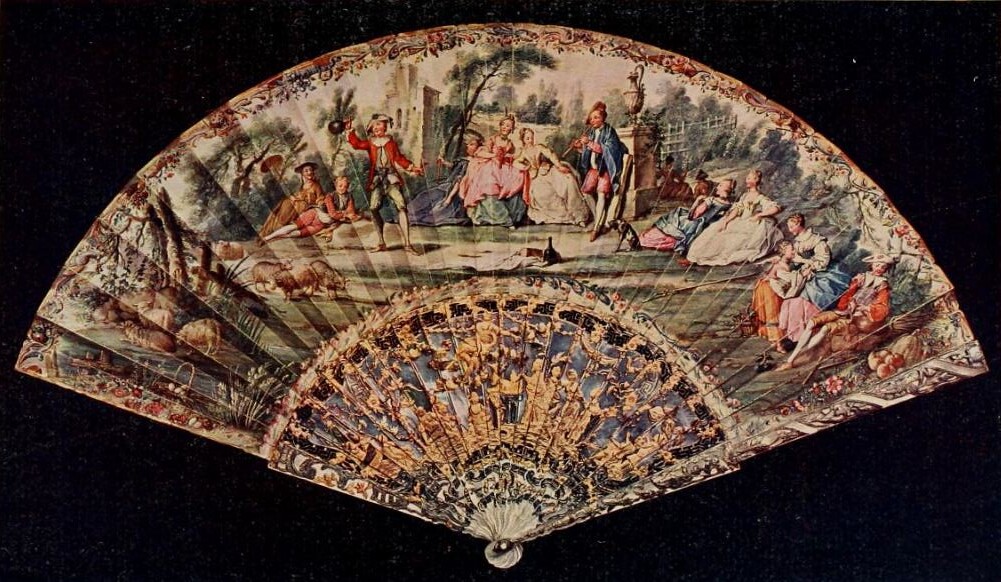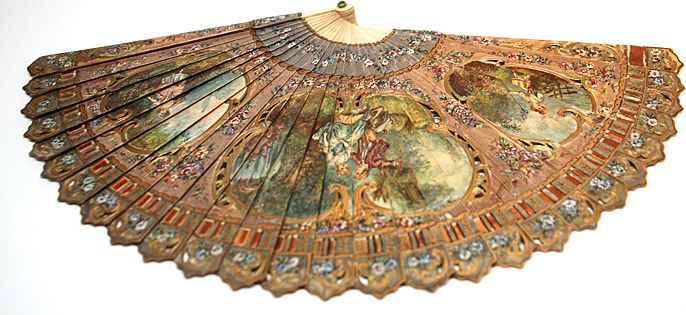Friday Fun Facts - 11/22/2013

Here are this week's Friday Fun Facts about Diana Gabaldon's books.

1) The fan was an important fashion accessory for upper-class ladies in the 18th century. The one above is from France, circa 1750. (Photo credit: CharmaineZoe, on Flickr. Click on the photo for a bigger view.)
"Men,” I told him, “have no notion of fashion. But not to worry. The seamstress says that’s what the fan is for.” I flipped the matching lace-trimmed fan open with a gesture that had taken fifteen minutes’ practice to perfect, and fluttered it enticingly over my bosom.
Jamie blinked meditatively at this performance, then turned to take my cloak from the wardrobe.
“Do me the one favor, Sassenach,” he said, draping the heavy velvet over my shoulders. “Take a larger fan."
(From DRAGONFLY IN AMBER by Diana Gabaldon, chapter 9, "The Splendors of Versailles". Copyright© 1992 by Diana Gabaldon. All rights reserved.)

This exquisitely detailed 18th century French fan is an example of a style called "brisé", painted scenes placed on individual ivory sticks, held together by an interlacing ribbon. (Photo credit: Paris Chateau)
Look here for some interesting information about the "language of the fan" in the 18th century. For more information about the types of fans used in the 18th century, look here.

2) You may remember Jamie and Claire's conversation about owls, in DRAGONFLY:
Returning to his earlier remark, I said, "Why did you say ‘tight as an owl’? I’ve heard that before, to mean drunk, but not costive. Are owls constipated, then?”
Completing his course, he flipped over and lay on the rug, panting.
“Oh, aye.” He blew out a long sigh, and caught his breath. He sat up and pushed the hair out of his eyes. “Or not really, but that’s the story ye hear. Folk will tell ye that owls havena got an arsehole, so they canna pass the things they eat--like mice, aye? So the bones and the hairs and such are all made up into a ball, and the owl vomits them out, not bein’ able to get rid of them out the other end."
(From DRAGONFLY IN AMBER by Diana Gabaldon, chapter 7, "Royal Audience". Copyright© 1992 by Diana Gabaldon. All rights reserved.)
The photo above was taken at the the Scottish Owl Centre in Whitburn, West Lothian, Scotland. (Photo credit: mmcclair, on Flickr.)

What are owl pellets, exactly? According to this site,
Indigestible material left in the gizzard such as teeth, skulls, claws, and feathers are too dangerous to pass through the rest of the owl's digestive tract. To safely excrete this material, the owl's gizzard compacts it into a tight pellet that the owl regurgitates. The regurgitated pellets are known as owl pellets.
Owl pellets are useful to researchers because they can find out quite a bit about an owl's lifestyle through careful examination of the pellet's contents. Since most of the prey's bones are not actually broken during the attack and the subsequent digestion process, they can be readily identified in the pellet. Most pellets include a skull or skulls, which makes identification of the prey relatively simple.

3) You may recall Hermon Husband telling Jamie about James Nayler (1616-1660), an early Quaker.
"I am minded,” he said, glancing from Jamie to me, “of James Nayler. Thee will have heard of him?”
Jamie looked as blank as I did, and Hermon smiled in his beard.
“He was an early member of the Society of Friends, one of those who joined George Fox, who began the Society in England. James Nayler was a man of forceful conviction, though he was...individual in his expression of it. Upon one famous occasion, he walked naked through the snow, whilst shouting doom to the city of Bristol. George Fox inquired of him then, ‘Is thee sure the Lord told thee to do this?’ ”
The smile widened, and he put his hat carefully back on his head.
“He said that he was. And so am I, friend James. God keep thee and thy family."
(From THE FIERY CROSS by Diana Gabaldon, chapter 19, "The Devil Ye Ken". Copyright© 2001 by Diana Gabaldon. All rights reserved.)
According to this site,
Nayler [and a group of Friends] travelled in procession through Glastonbury and Wells and entered Bristol on 24 October [1656]. Nayler went on horseback while his companions sang hosannas and cast garments before him in what many regarded as a blasphemous imitation of Christ's entry into Jerusalem on Palm Sunday. The Bristol Quakers immediately disassociated themselves from Nayler and his followers, who were arrested and charged under the Blasphemy Act of 1650. Although Nayler maintained it was a symbolic act, he was accused of impersonating Christ and claiming divine status.
Nayler's punishment for his actions that day seems barbaric by modern standards. From Wikipedia:
On 16 December 1656 he was convicted of blasphemy in a highly publicized trial before the Second Protectorate Parliament. Narrowly escaping execution, he was pilloried and whipped through the streets of London, was branded with the letter B on his forehead, had his tongue pierced with a hot iron, and was then transported back to Bristol to be whipped through its streets too, before enduring two years imprisonment at hard labor.

4) The photo above shows what eyebright (Euphrasia) looks like. (Photo credit: Born.Free, on Flickr.)
The two men drew closer together, continuing their lopsided conversation with an increased intensity. Since Jamie’s part seemed to be limited mainly to grunts and exclamations of interest, I could glean little of the content, and busied myself instead with a survey of the strange little rock plants sprouting from the surfaces of our perch.
I had collected a pocketful of eyebright and dittany by the time they finished talking and Hugh Munro rose to go.
(From OUTLANDER by Diana Gabaldon, chapter 17, "We Meet a Beggar". Copyright© 1991 by Diana Gabaldon. All rights reserved.)
According to this site,
This plant has a long history of use for eye problems, hence the name of Eyebright. When used appropriately, eyebright will reduce inflammation in the eye caused by blepharitis (inflammation of the eyelash follicles) and conjunctivitis (inflammation or infection of the membrane lining the eyelids). It can be used as an eye wash, as eye drops, or plant infusions taken internally for ophthalmic use.
For more information about eyebright, look here.
(Note to those of you in the UK, Australia, and New Zealand: the passage I quoted above from OUTLANDER was changed in CROSS STITCH to replace the reference to eyebright with another plant. Look here for my detailed analysis of the differences between OUTLANDER and CROSS STITCH.)

5) This photo from Colonial Williamsburg shows all the items you'd need for doing laundry in the 18th century. Now imagine doing it outdoors in summer:
It was much hotter in the yard, with the laundry fire roaring, and quite as damp as it had been in the cell, with the thick clouds of moisture boiling off the big kettle of clothes and plastering strands of hair to our faces. Our shifts already clung to our bodies, the grubby linen almost transparent with sweat--laundry was heavy work. There were, however, no bugs, and if the sun shone blinding, and fierce enough to redden my nose and arms--well, it shone, and that was something to be grateful for.
(From A BREATH OF SNOW AND ASHES by Diana Gabaldon, chapter 92, "Amanuensis". Copyright© 2005 by Diana Gabaldon. All rights reserved.)
Here's an article about "the complexities of wash day in the 18th century". And here's an interesting page about the history of laundry.
I hope you enjoyed these Friday Fun Facts! Look here to see all of my Friday Fun Facts blog posts.
Please note: Between the Thanksgiving holiday and other family obligations, I will be spending a lot of time traveling in the next two weeks, so I will be taking a little break from the FFF. Look for the next installment of the Friday Fun Facts to be posted on December 13.







Charlene